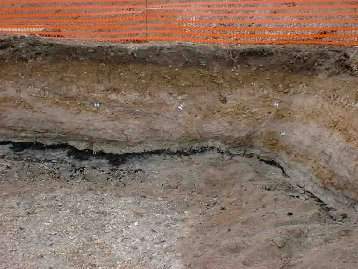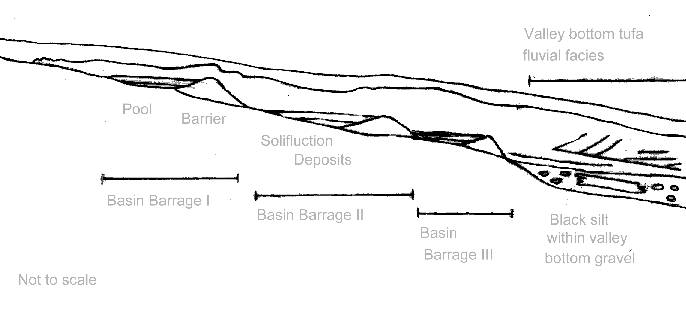At https://archive.is/zSsqZ … I was looking at the archaeology pages on this web site and flicked on to this page, 'Stratigraphy and Paleoenvironmental Sampling' which is quite revealing as early to mid Holocene is not something you see mentioned much in geology as most of it is absent from most locations. I don't know why they use the American spelling for paleoenvironmental (rather than palaeoenvironmental) or perhaps it's me that is wrong. The findings come from three trenches cut in a river valley in SW Hertfordshire (between Watford and Hemel Hempstead). It provided some interesting geology for the Late Glacial to early Holocene transition which in most locations seems to be absent (or eroded away). The sequence runs across the centre and sides of the valley. As can be expected the centre of the valley has a lot of peat layering and what they call tufa deposits. These are important as they illustrate that what is being investigated is a marshy landscape.
Trench 1 is the middle section of the valley. Trench 2 is set over the valley edge and trench 3 was executed from the valley side and across the valley floor and provided a mixture of clay and gravel rich sediments (some of them containing chalk from the hills above) and cold climate periglacial solifluction deposits (sliding down the valley sides). I won't go into a description of the solifluction process but it occurs on the chalk all over southern Britain (and along the nearby escarprment). You can Google the word or put it into Wiki. The reason I have included a link to this study by Dr Martin Bates (2000) is that occurrence of black (organic) silts that he thinks 'may belong to the late glacial interstadial' which is of course the Younger Dryas Event.


Do we have evidence of the black mat thin layer at the YD boundary that Han Kloosterman found in the Netherlands and the YDB people have explored in North America and other parts of the world? If the black mat has an origin in landscape fires caused by atmospheric explosions of comet fragments it should not be confined to one sole region in the northern hemisphere but should be evident in Late Glacial geology everywhere (in particular in NW Europe). How many other studies have unearthed evidence of a black organic layer. Han Kloosterman was taken by to a site beneath Pitstone Hill just below the escarpment by John Evans back in the 1980s which had a similar black layer of the same period of time – but this site is out of bounds as it is in a quarry and nothing of the black layer can now be seen. It would require a re-excavation. This was mentioned in an early SIS journal.
